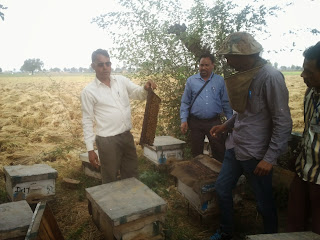Introduction:
In a world grappling with economic uncertainties, the buzz around beekeeping is becoming more than just a faint hum. This age-old practice isn’t just about honey; it’s increasingly recognized as a viable solution to combat unemployment and create a thriving community. From supporting biodiversity to fostering entrepreneurship, beekeeping offers a host of benefits that can’t be ignored.
A Thriving Biodiversity Hub:
Beekeeping isn’t just about the bees; it’s about nurturing an entire ecosystem. As bees flit from flower to flower, they’re not just pollinating plants, but also helping to sustain a delicate balance in nature. This activity fosters biodiversity, which in turn supports a healthier environment for everyone. Unemployment might seem like a daunting issue, but beekeeping offers a way to be a steward of nature while finding purpose.
Cultivating Green Collar Jobs:
Beekeeping is a multifaceted venture that requires skills ranging from hive management to honey extraction. By embracing beekeeping, individuals can acquire new skills and find employment in a growing industry. From tending hives to marketing bee-related products, these “green collar” jobs not only provide a source of income but also empower people with valuable skills that can be utilized elsewhere.
Small-Scale Entrepreneurship:
Beekeeping isn’t confined to vast landscapes; it can be embraced on a small scale, even in urban areas. This presents an opportunity for aspiring entrepreneurs to establish a micro-business. Selling honey, beeswax products, and even offering beekeeping workshops can be a source of income that not only addresses unemployment but also encourages innovation and community engagement.
Healing Benefits of Beekeeping:
Beyond economic gains, beekeeping offers therapeutic benefits too. The act of caring for bees and connecting with nature has been proven to reduce stress and improve mental well-being. In communities grappling with unemployment, this can be a much-needed silver lining. Beekeeping can foster a sense of purpose and belonging, helping individuals cope with the challenges of joblessness.
Educational and Social Impact:
Beekeeping is a fascinating subject that can captivate people of all ages. Embracing beekeeping can open doors to educational opportunities and community building. Schools can incorporate beekeeping into their curriculum, providing students with hands-on learning experiences. This not only imparts practical knowledge but also instills a sense of responsibility towards the environment.
Conclusions:
In a world where unemployment can often feel like an insurmountable challenge, beekeeping stands as a testament to the power of innovation and community involvement. By engaging with beekeeping, individuals can tap into a world of biodiversity, economic opportunity, and personal growth. As the buzz around beekeeping grows louder, it’s time to recognize its potential to sweeten the lives of those struggling with unemployment.

